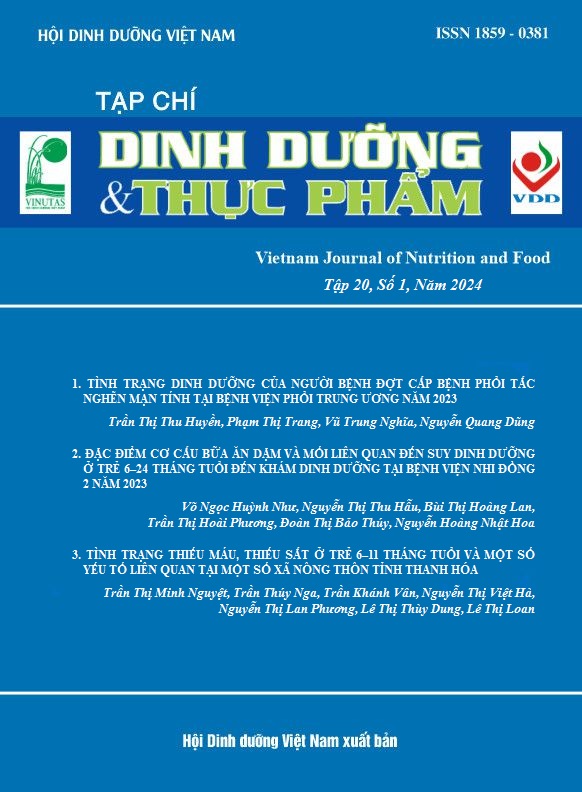CHARACTERISTICS OF COMPLEMENTARY FEEDING AND ASSOCIATION TO NUTRITION STATUS OF CHILDREN AGED 6 - 24 MONTHS AT THE NUTRITIONAL CONSULTATION UNIT OF CHILDREN’S HOSPITAL 2 IN 2023
Main Article Content
Abstract
Aims: To determine characteristics of complementary feeding and association to malnutrition of children aged 6-24 months who visit the Nutrition Clinic of Children's Hospital 2 in 2023.
Methods: A descriptive cross-sectional study, was conducted in 271 children with nutrition examination at the Nutrition Clinic of Children's Hospital 2 from April to June 2023.
Results: Malnutrition rate of underweight, stunting, and wasting in the children was 25.09, 24.35, and 13.65%, respectively. The older the age, the higher the rate of eating enough carbohydrates and protein; while the lower the rate of eating enough lipids.
Recommendation minimum energy was still low, accounting for 45.39%. The higher the group's energy from carbohydrates reaching the recommended range of 55 - 65%, the lower the rate of underweight malnutrition (p=0.042).
Conclusion:The rate of malnutrition was still high. The young (aged 6-9 months) were at risk of carbohydrate and protein insufficiency, and the older (group aged 12-24 months) were at risk of lipid insufficiency. Mothers should be trained how to feed their children.
Keywords
Malnutrition, complementary feeding, children 6-24 months
Article Details
References
2. Viện Dinh dưỡng Quốc gia. Tỉ lệ suy dinh dưỡng trẻ em <5 tuổi theo các mức độ, theo vùng sinh thái. Accessed 31/10/2022, http://chuyentrang.viendinhduong.vn/FileUpload/Documents/Nam%202022/(2020)%20TL%20suy%20dinh%20duong%20TE%20duoi%205%20tuoi%20theo%20muc%20do,%20vung%20sinh%20thai.pdf
3. Sagaro GG AM. Dietary diversity and associated factors among infants and young children in Wolaita zone, southern Ethiopia. Sci J Clin Med. 2017;6(4):53. doi:10.11648/j.sjcm.20170604.12.
4. Trịnh Bảo Ngọc, Nguyễn Thị Như Quỳnh, Nguyễn Thị Thu Liễu. Một số yếu tố liên quan tới tình trạng dinh dưỡng của trẻ dưới 24 tháng tuổi đến khám tại Trung tâm Kiểm soát bệnh tật tỉnh Bắc Giang 2020. Tạp chí Nghiên cứu Y học. 2021;146(10):206-213. doi:10.52852/tcncyh.v146i10.343
5. World Health O. Guideline: assessing and managing children at primary health-care facilities to prevent overweight and obesity in the context of the double burden of malnutrition. World Health Organization; 2017.
6. Bộ Y tế. Nhu cầu dinh dưỡng khuyến nghị cho người Việt Nam. 2016.
7. Lutter CK, Grummer-Strawn L, Rogers L. Complementary feeding of infants and young children 6 to 23 months of age. Nutrition Reviews. 2021;79(8):825-846. doi:10.1093/nutrit/nuaa143
8. Who. Indicators for assessing infant and young child feeding practices: definitions and measurement methods . vol 0. WHO/UNICEF Technical expert advisory group on nutrition monitoring (TEAM); 2021:0.
9. Lưu Thị Mỹ Thục, Phạm Thu Hiền, Nguyễn Thị Thúy Hồng. Tình trạng dinh dưỡng của trẻ từ 6-24 tháng tuổi nhập viện tại Bệnh viện Nhi Trung ương. Tạp chí Y học dự phòng. 2018;28(12):35.
10. Nguyễn Thị Thu Hậu, Trần Thị Hoài Phương, Nguyễn Hoàng Nhựt Hoa, Trần Hồng Nhân. Khảo sát chất lượng bữa ăn dặm cho trẻ từ 6-24 tháng tuổi đến khám dinh dưỡng tại Bệnh viện Nhi đồng 2. Tạp chí Y học TP Hồ Chí Minh. 2010;14(4):277.
11. Lin A, Nichols B. The digestion of complementary feeding starches in the young child. Starch - Stärke. 2017;69. doi:10.1002/star.201700012.


